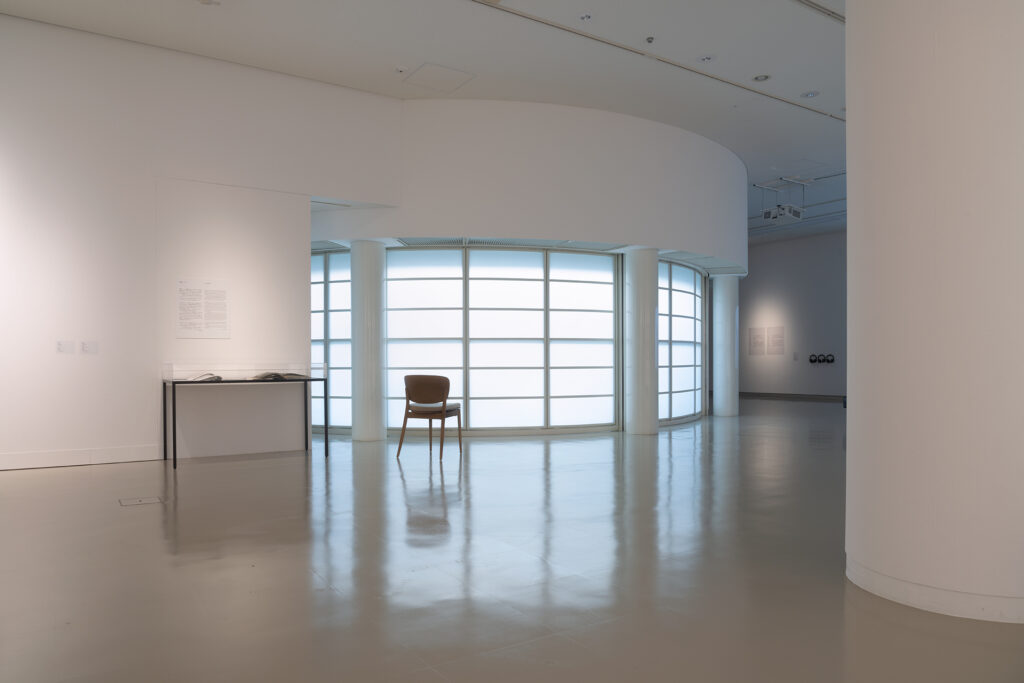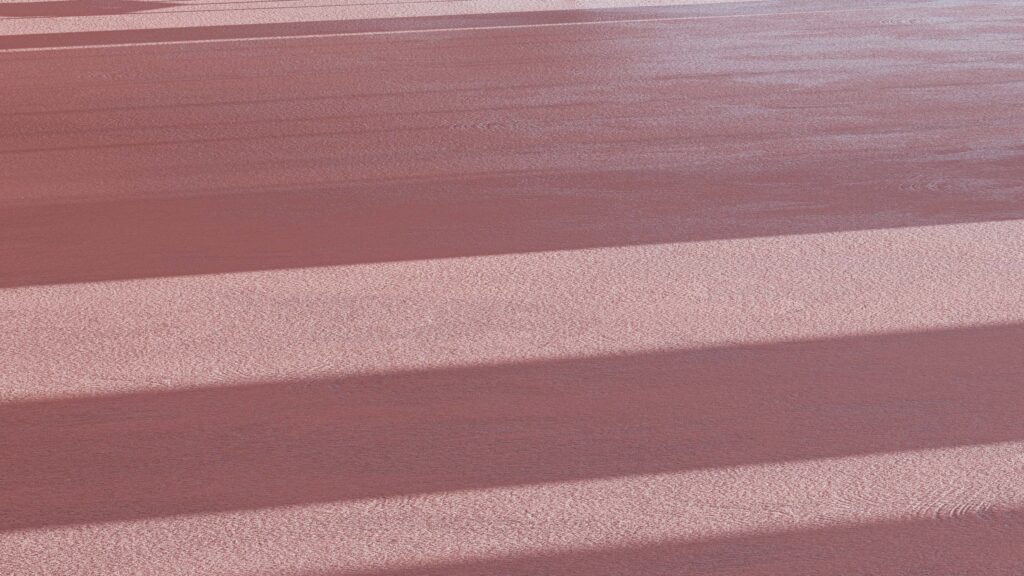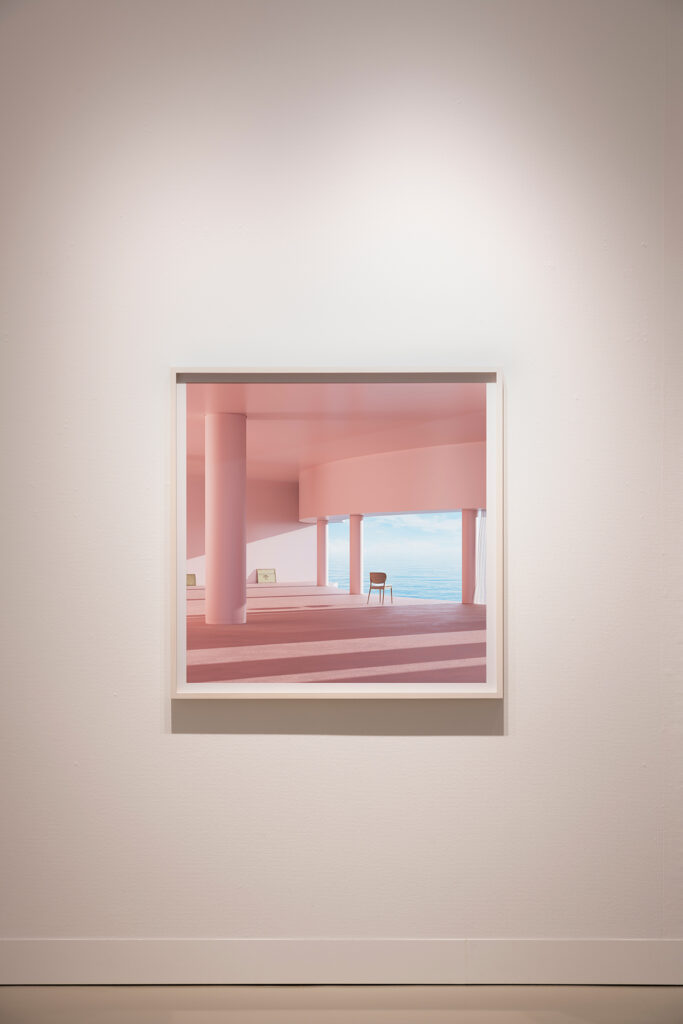
Light Court
2024, Inkjet print
CGI: SUNJUNJIE
Created with computer graphics (CG), this work is an interior portrait of the light court in the Hiroshima City Museum of Contemporary Art. Harada was born in 1989, the same year as when the museum was opened. He often visited it beginning in his teens, and dreamed of becoming an artist. This work was produced for a solo exhibition of his at the museum in 2024. It presents a worldview that seems to fuse the post-modern architecture of the museum, which was designed by Kisho Kurakawa, and the virtual space of a dreamscape from the tide of expression using computer-generated imagery (CGI).
Placed in the space, where time seems to have stopped, is the Valencia chair crafted by Yonoh, the Spanish design studio. On the walls and floors are the slanting rays of a “white sunset” inspired by the works of Edward Hopper, the quintessentially American painter.


Photo: Katsura Muramatsu
光庭
2024年、インクジェットプリント
CGI:SUNJUNJIE
本作は、広島市現代美術館にある光庭(ひかりにわ)を題材にCGで描かれた室内画である。広島出身の原田は、自身の生年と同じ1989年に開館したこの美術館に10代のころから通い、アーティストになることを夢見るようになった。2024年に広島市現代美術館で開催された個展のために制作された本作では、黒川紀章が設計した同館のポストモダン建築と、CGI表現の潮流「ドリームスケープ」の仮想空間が融合したかのような世界観が示されている。
まるで時が止まったかのような空間に配置されているのは、スペインのデザインスタジオ、Yonoh(ヨノ)が手掛けたバレンシア・チェア。そして壁や床面には、アメリカの国民的画家、エドワード・ホッパーの作品に着想を得た「白い夕陽」が差し込んでいる。

──About Light Court
The model for this space was the light court in the Hiroshima City Museum of Contemporary Art.
For me as a native of Hiroshima, the Hiroshima MOCA was a special place and was born in 1989, the same year as I. Designed by Kisho Kurokawa, it was like a temple and also futuristic. When I went there, I was able to escape from the drab realities of my childhood, if only temporarily.
Now I am an adult, and am going to have a solo exhibition at this museum. I had in mind displaying a work in the light court, which I found particularly impressive. Nevertheless, I was unable to settle on an exhibition proposal no matter how hard I tried. The more I thought about it, the more I came to think that this space was conceived as a void that would not be suitable for any exhibit.
Instead of displaying a work in the light court, I therefore decided to use the light court itself as a subject. The result was the birth of this work.
In the middle of the work is the iconic Valencia chair created by the Spanish design studio Yonoh. And in the room, I rendered incident light from a pale setting sun that the quintessentially American artist Edward Hopper was fond of painting.
A single chair placed in a patch of sunlight in silent space. When you sit on it, what sort of scene will meet your eyes?
──《光庭》について
この空間のモデルになったのは、広島市現代美術館にある「光庭(ひかりにわ)」だ。
広島出身のぼくにとって、自身と同じ1989年に生まれた広島現美は特別な場所だった。黒川紀章が設計したこの美術館は、神殿のようであり、未来的でもあり、ここに来ることでくだらない現実から一時的にでも逃れることができるのだった。
大人になったいま、この美術館で個展ができることが決まり、特に印象的だった光庭に作品を置きたいと思った。しかし、どうやっても展示案が決まらない。考えれば考えるほど、この空間はいかなる展示にも適さない「ボイド」として構想されたように思えたからだった。
そこで、光庭に作品を設置する代わりに、光庭じたいを題材にしてみることにした。そうして生まれたのがこの作品だ。
画面の中には、スペインのデザインスタジオ「Yonoh(ヨノ)」が手掛けた名作椅子、バレンシア・チェアを配置した。そして室内には、アメリカの国民的画家、エドワード・ホッパーが好んで描いた「白い夕陽」を差し込ませてみた。
音のないひだまりに置かれた一脚の椅子。そこに腰掛けたときに目に映るのは、果たしてどのような光景なのだろうか。

Photo: Katsura Muramatsu